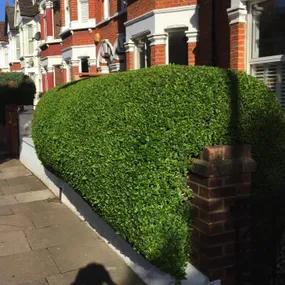Pre-Order Bareroot Privet Hedging For 2025/26 Winter Season
What is Privet Hedging?
Evergreen Privet, Ligustrum ovalifolium, both the Green and variegated Golden varieties, are probably the most popular urban hedge plants.
It grows in compacted, polluted soil next to roads, tolerates shade, can be clipped to make a smart formal look, and is low maintenance. It grows quickly and can be hard pruned.
- Uses: Formal hedges from 80cm up to 3 metres, and topiary
- Good Points: Evergreen, dense, tolerates pollution, clips beautifully
- Position: Almost anywhere, including dry shade
Wild Privet, Ligustrum vulgare, is not evergreen, although it tends to hold its leaves longer than most other plants. It is great for wildlife, and a common element in conservation hedge mixes.
- Uses: Mixed country hedges from 80cm upwards
- Good Points: Native, great for wildlife dense, tolerates pollution
- Position: Almost anywhere, including dry shade
How many Privet hedge plants do I need?
The planting density for your Privet hedge depends on the purpose:
- For a normal garden boundary hedge, plant at 3 plants per metre (every 33cm) in a single row.
- An interior hedge for purely decorative purposes can be planted at 2 plants per metre (every 50cm) in a single row.
What size Privet hedge plants should I buy?
- If you are not in a hurry to get a full sized Privet hedge, we recommend starting with smaller sizes: up to 60cm tall.
- If you are in a hurry and need instant impact, or are filling gaps in an existing hedge, then of course pick the biggest size that fits your budget.
Smaller plants are cheaper, easier to plant, and tend to establish better because they are dug up with most of their roots intact.
You can also clip them attentively and ensure a very bushy plant from the base up.
If you still aren't sure, then 60/80cm tall is considered the ideal compromise between price, size, and waiting time until you get a mature hedge.
Your mail order Privet hedge plants are delivered by next working day courier.
If there is anything wrong with your plants when they arrive, Contact Us within 5 working days, and our friendly support team will sort it out.
All bareroot plants are covered by our Refund Guarantee, so you can give them a whirl with complete confidence.
Browse our other hedging plants.
Privet hedging is foolproof, bombproof, low-maintenance, and yet still attractive and versatile, great for topiary.
Which Privet Variety Should I Choose?
Green Privet is the cheapest evergreen variety, and makes the best backdrop for flower borders.
Golden Privet is a bit more expensive, but to make it more affordable we supply it more sizes. If your garden is only a lawn or patio and a hedge, this more exciting variety is best.
Its vivid foliage might be an overwhelming backdrop for the average flower border, but could work well around a purple themed border.
Wild Privet is best for supporting wildlife, great for adding to mixed country hedges or conservation hedges.
It's not evergreen, so not the first choice for most urban gardens where you will see it all the time.
What is the difference between Bareroot and Pot-Grown Privet?
Bareroot privet plants are by far the best value, the easiest to handle & plant because they weigh so little, and offer the most selection.
They are only delivered during winter and early spring, about November to March, when the plants are dormant, which is the best time of year to plant almost all woody species.
Some plants or larger sizes can only be delivered in pots, and some popular species are sold both bareroot in winter and potted the rest of the year.
There is nothing wrong with Pot Grown plants, but where you have a choice, bareroot is always even better!
Where can I grow a privet hedge?
You can grow a Privet hedge anywhere in the UK where there is decent soil drainage and some sunlight.
It grows in any soil type, tolerates partial shade, is wind-resistant and suitable for the coast, and it is both very hardy and drought tolerant.
It is immune to urban pollution.
Note that while Ligustrum ovalifolium (Green and Gold Privet) are usually evergreen in most parts of the UK, like many broadleaf evergreens they might still lose their leaves in harsh mid-winters, especially in exposed or coastal locations. This is perfectly normal.
How long does it take a privet hedge to grow?
Privet plants are moderately vigorous, growing up to 50-60cm per year, depending on your location (plants generally grow faster in the warmer South & West than in the cooler East & North of Great Britain) and your local conditions (wind-shelter and full sun are ideal).
However, as with any hedge, you must trim it to get lots of dense, bushy growth down to the base. So, there is a balance to be struck: aim for about 30cm of growth after trimming in the first few years.
Bear in mind that it is common for most plants to put on very little height in their first year after being transplanted into your garden.
There is nothing wrong with this: they are laying down roots first, in readiness for growing upwards and filling out.
How big does a Privet hedge grow?
A privet hedge can be maintained from about 1 metre up to about 5 metres.
When and How do I plant a privet hedge?
For Green & Gold Privet, follow the instructions in our formal hedge planting video - it demonstrates beech, but it's the same process.
For Wild Privet, follow the instructions in our country hedge planting video.
When is the best time to plant Privet?
You can plant privet hedging at any time of year, except when the soil is frozen.
The best time to plant privet is in winter (November to March), using bareroot stock, which is cheaper, easier to carry and plant, and tends to establish even better than the pot grown equivalents.
How and When should I prune a privet hedge?
Privet is very tough and disease free, so you can trim it at any time of year without harming it.
Trimming New Privet Hedges: Immediately after Planting
Green & Gold privet: After planting, trim off the very end of each stem, an inch is plenty.
Wild Privet: After planting, as with any country hedge plant, prune them down by 50%
Trimming New Privet Hedges: The First Few Years
While your privet hedge is reaching the desired height, you can trim it lightly all over in Spring, and then trim the only sides again in Autumn, leaving the top alone if growth is not very vigorous.
If the top growth gets sparse and straggly, then trim it as well.
Trimming Mature Privet Hedges
Privet hedging looks best when clipped at least twice per year, ideally in early spring and early autumn.
To keep a really neat, formal look, a third clip in summer may be necessary.




 1.webp)

 hedging 3.webp)